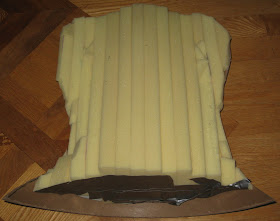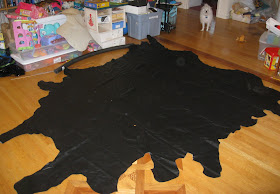First, I removed the foam insulation tube from the chair form. I took the leather strip for the foam insulation tube and glued it onto the tube directly, with one long edge tucked into the slit of the tube and the other edge loose. Then I glued the big piece of leather directly onto the outside of the Deck-o-foam-covered Sonotube. Finally, I put the leather-covered insulation tube back around the edge of the leather-covered Sonotube and glued everything down (the loose edge of the leather on the insulation tube is glued to the inside of the Sonotube).
 Here is how the back looks.
Here is how the back looks.
Cushions
Now that the outside of the chair is done, it's time to get back to work on the cushions.
For the round seat cushion, I cut three layers of 2-inch-thick, high-density polyurethane foam and stacked them inside the cover. I then stapled the cover very tightly onto one of the plywood circles.


For the back cushion, I cut out a piece of the scrap Sonotube so it would fit into the opening inside the insulation tube in the back of the chair.

I used the scraps of high-density foam left over from my denim-quilted dining room chairs to pad the back cushion. Since I wanted to contour the cushion to provide some lumbar support (opposite the direction of the Sonotube at the lower back area), it took some careful arranging!


Lacey shows off the careful use of duct tape to secure the foam scraps.

I wrapped a piece of the blue-green leather around the back assembly and fitted it in tightly, gluing down the leather flaps at the bottom to the inside of the main Sonotube piece. The piece of Sonotube inside the back cushion also helps to strengthen the back of the chair.

 The seat cushion then got shoved up against the bottom of the back cushion. To fit the seat cushion properly against the back cushion, I needed to take it out, take off the seat cover, cut off some foam, and restaple the leather more loosely (besides, I didn't like the shiny stretched look of the tightly-stapled leather). I got it right eventually.
The seat cushion then got shoved up against the bottom of the back cushion. To fit the seat cushion properly against the back cushion, I needed to take it out, take off the seat cover, cut off some foam, and restaple the leather more loosely (besides, I didn't like the shiny stretched look of the tightly-stapled leather). I got it right eventually.
But Will It Hold My Weight?
The Sonotube is sturdy, but it's meant to meant to take outward-pushing stresses that cause tension around its circumference, not just downward along the axis of the tube. To deal with this, I want to make the plywood circles carry the weight, not the tube. I glued some wood pieces into the tube up against the top circle. Their job is to hold the plywood circles apart. I screwed the bottom circle into the wood pieces.
 I added feet to the bottom circle so the Sonotube is suspended slightly above the floor and does not directly carry the weight of the chair's occupant.
I added feet to the bottom circle so the Sonotube is suspended slightly above the floor and does not directly carry the weight of the chair's occupant.
Finished!
I had to be the first to try out the chair, and Lacey decided she had to join me!
 Yes, it holds my weight just fine. I later tested it out with a much-heavier friend, and it held him with no trouble (he thought it was pretty comfy, so I had a hard time getting him out of it).
Yes, it holds my weight just fine. I later tested it out with a much-heavier friend, and it held him with no trouble (he thought it was pretty comfy, so I had a hard time getting him out of it).But Wait, There's More!
It would hardly be a proper TV chair without a matching ottoman, so I got a piece of 12-inch-diameter Quiktube and made one. I cut three lengths (9 inches plus two 7.5-inch pieces), and cut out thin sections out of the two short pieces so I could fit them inside the longer one to strengthen it (the 12-inch diameter tube is much thinner than the 18-inch-diameter Sonotube). I used the scraps of the leathers and cushion foam. I covered the outer tube with the black leather (no Deck-o-foam), and made the seat cushion the same way as the larger one, by stapling the leather over the foam onto a pre-cut plywood circle.
I glued wood pieces inside the tube between the plywood circles, and I screwed on the bottom plywood circle. Done!

Here's the set.

It's not the cheapest chair (it totaled about USD $250 for the set), but it's unique, small, comfortable, and my kids love it.
Getting to sit in my own chair without a fight: priceless.
 A satisfied customer. It's just her size.
A satisfied customer. It's just her size.



































